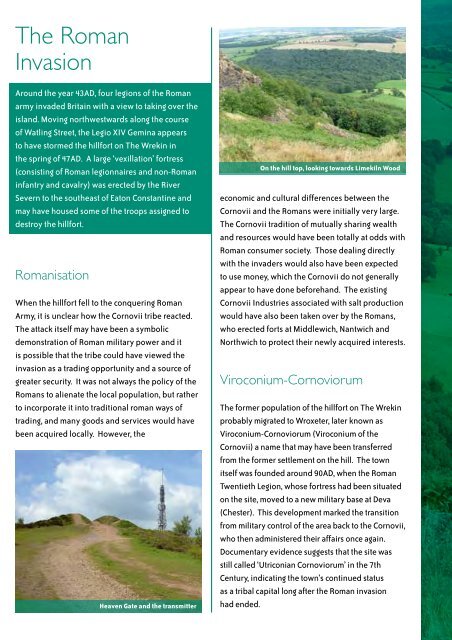All Round The Wrekin - Wellington Local Agenda 21 Group
All Round The Wrekin - Wellington Local Agenda 21 Group
All Round The Wrekin - Wellington Local Agenda 21 Group
Create successful ePaper yourself
Turn your PDF publications into a flip-book with our unique Google optimized e-Paper software.
<strong>The</strong> Roman<br />
Invasion<br />
Around the year 43AD, four legions of the Roman<br />
army invaded Britain with a view to taking over the<br />
island. Moving northwestwards along the course<br />
of Watling Street, the Legio XIV Gemina appears<br />
to have stormed the hillfort on <strong>The</strong> <strong>Wrekin</strong> in<br />
the spring of 47AD. A large ‘vexillation’ fortress<br />
(consisting of Roman legionnaires and non-Roman<br />
infantry and cavalry) was erected by the River<br />
Severn to the southeast of Eaton Constantine and<br />
may have housed some of the troops assigned to<br />
destroy the hillfort.<br />
Romanisation<br />
When the hillfort fell to the conquering Roman<br />
Army, it is unclear how the Cornovii tribe reacted.<br />
<strong>The</strong> attack itself may have been a symbolic<br />
demonstration of Roman military power and it<br />
is possible that the tribe could have viewed the<br />
invasion as a trading opportunity and a source of<br />
greater security. It was not always the policy of the<br />
Romans to alienate the local population, but rather<br />
to incorporate it into traditional roman ways of<br />
trading, and many goods and services would have<br />
been acquired locally. However, the<br />
Heaven Gate and the transmitter<br />
On the hill top, looking towards Limekiln Wood<br />
economic and cultural differences between the<br />
Cornovii and the Romans were initially very large.<br />
<strong>The</strong> Cornovii tradition of mutually sharing wealth<br />
and resources would have been totally at odds with<br />
Roman consumer society. Those dealing directly<br />
with the invaders would also have been expected<br />
to use money, which the Cornovii do not generally<br />
appear to have done beforehand. <strong>The</strong> existing<br />
Cornovii Industries associated with salt production<br />
would have also been taken over by the Romans,<br />
who erected forts at Middlewich, Nantwich and<br />
Northwich to protect their newly acquired interests.<br />
Viroconium-Cornoviorum<br />
<strong>The</strong> former population of the hillfort on <strong>The</strong> <strong>Wrekin</strong><br />
probably migrated to Wroxeter, later known as<br />
Viroconium-Cornoviorum (Viroconium of the<br />
Cornovii) a name that may have been transferred<br />
from the former settlement on the hill. <strong>The</strong> town<br />
itself was founded around 90AD, when the Roman<br />
Twentieth Legion, whose fortress had been situated<br />
on the site, moved to a new military base at Deva<br />
(Chester). This development marked the transition<br />
from military control of the area back to the Cornovii,<br />
who then administered their affairs once again.<br />
Documentary evidence suggests that the site was<br />
still called ‘Utriconian Cornoviorum’ in the 7th<br />
Century, indicating the town’s continued status<br />
as a tribal capital long after the Roman invasion<br />
had ended.


